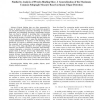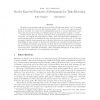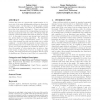115 search results - page 18 / 23 » Geometric graphs with no two parallel edges |
ISDA
2009
IEEE
14 years 2 months ago
2009
IEEE
—Protein binding sites are often represented by means of graphs capturing their most important geometrical and physicochemical properties. Searching for structural similarities a...
PODC
2004
ACM
14 years 25 days ago
2004
ACM
We study a representative task allocation problem called shortest paths: Let G be a graph in which the edges are owned by self interested agents. The cost of each edge is privatel...
SPAA
2006
ACM
14 years 1 months ago
2006
ACM
Synchronization is often necessary in parallel computing, but it can create delays whenever the receiving processor is idle, waiting for the information to arrive. This is especia...
PODC
2006
ACM
14 years 1 months ago
2006
ACM
Coloring the nodes of a graph with a small number of colors is one of the most fundamental problems in theoretical computer science. In this paper, we study graph coloring in a di...
ISAAC
2004
Springer
14 years 23 days ago
2004
Springer
For c ∈ R, a c-spanner is a subgraph of a complete Euclidean graph satisfying that between any two vertices there exists a path of weighted length at most c times their geometric...



